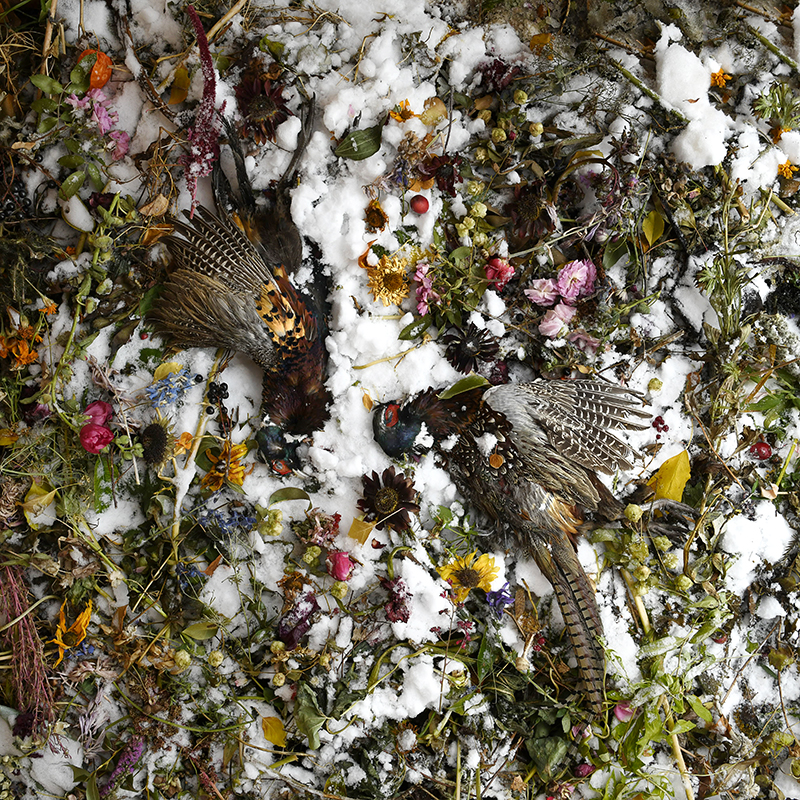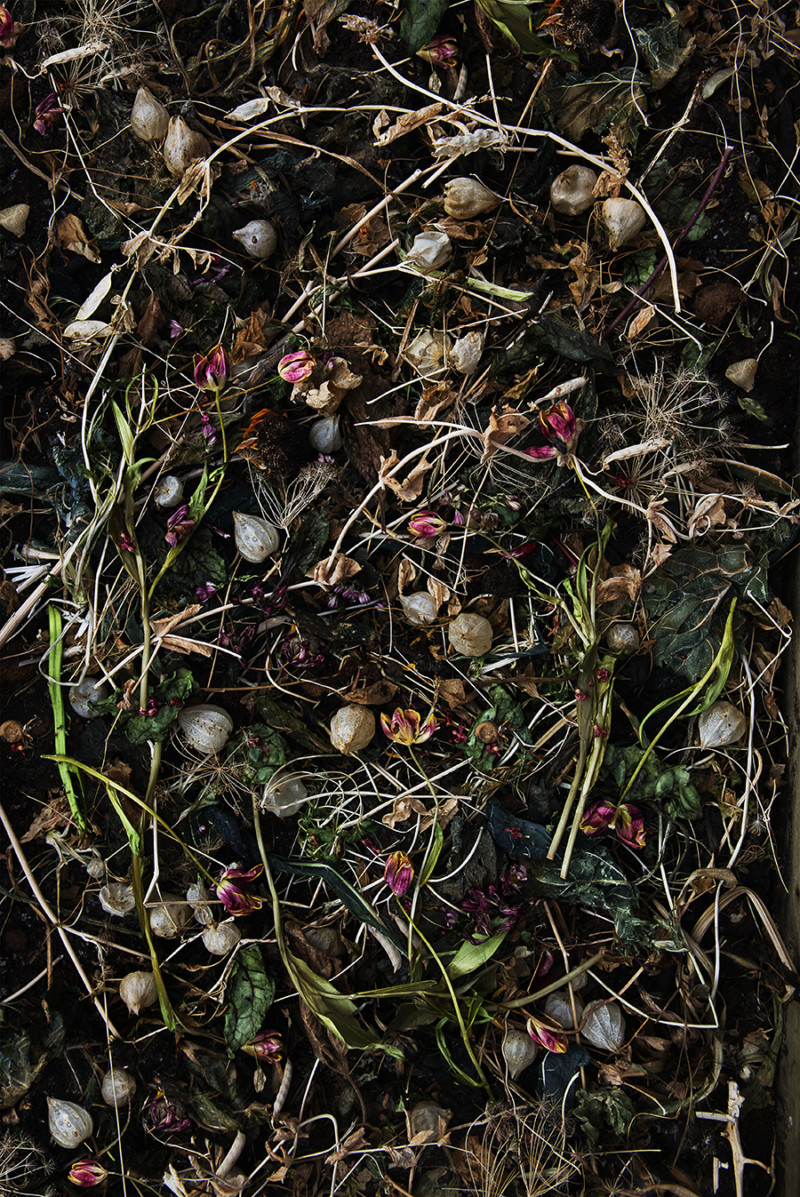Rocio Graham is a photographer currently based in Calgary. Born in Mexico, she emigrated to Canada in 2002, studying art at Emily Carr University and the Alberta College of Art + Design, where she recently obtained a Bachelor of Design in Photography. Her poignant still lives are influenced by her cultural heritage, identity as a woman and mother, and reflections on life cycles. Fittingly, Graham’s home and garden serve as her studio—a centre for research and development—where her elaborate compositions begin the moment she selects a seed to nurture in the spring until the final stages of decay and decomposition in the cold winter.
She finds that this constant shift of landscape allows her to explore it not only as a physical space, but as a mystical one.

First, tell us how you originally started working in the medium of photography? What about photography was most appealing to you?
For the first twenty years of my life poetry was my artistic medium but after a traumatic event in my 20’s I couldn’t write poetry anymore. I lost my art language and I needed to find another way to express myself. I was also living in South Korea where I could not speak very well Korean so photography became this visual language that I felt it was universal and allowed me to connect with others. I loved the instant gratification of the medium and the mobility of it.
You originally are from Mexico and you moved to Canada back in 2002. How did that move between cultures and places affected your work or your practice?
When I left Mexico and moved to Korea, and later Canada, I felt lost for a while. I had to re examine my identity and my sense of self in this new country. I needed to find a new blueprint for a new way of being. I reconnected through revisiting ways of being that I had taken from granted all my life. Ways of the land, of the earth, of life. My Mexican family has cultivated the land for generations ( Watermelons, beans, sugar cane etc) so I went back to that knowledge and started exploring my new land from my old roots. That is when my interest in land art and landscape photography began. It has been a full circle process for me.



I came across your work at Sand Diego portfolio review and the things that originally cough my eye was your large panoramic print which immediately made me want to see more of your work. Work is mainly still lives – can you tell us the process of making each photo – from studio to the final image.
My studio is in my garden but since I live in growing zone 3 our ground is frozen until May. I start my artistic process growing plants and flowers from seed in my basement in the winter. The plants are moved outdoors to my greenhouse and to the garden in my backyard in the spring where they are nurtured and harvested periodically. I have a couple of compost areas where the organic materials are laid to decompose. I slowly build an organic composition in the compost bin where the fresh and decayed materials start a conversation. I place layers after layers until I feel ready to photograph a piece with my full frame digital camera. Since I work outdoors without any protection from the elements there is a lot of unpredictability. I may work for weeks on a piece, then it gets covered by unexpected snow and I have to start the process again. It’s a constant exercise in surrendering to the forces of nature. Instead of fighting that, I have embraced it and accepted nature’s interventions. My current pieces are 40 x 80 inches but I’m planning on enlarging them to fit bigger exhibition spaces.
Your work is very reminiscing of traditional Vanitas paintings where death and mortally have a key rule in their motifs. Did these painting ever influence you in any way? Why were you drawn to these types of symbols and visuals in your own work?Is it important is it for you to have all these symbols in your work?
I’m delighted that you noticed that aspect of my work because it is very intentional. The work of the master Dutch still life painters has deeply influenced my art practice. During my undergraduate studies all my research was on this devalued genre. I was attracted to that aesthetic because of the deep symbolism used, and because of the skilled way light was used to create emotion. In Mexican culture we have a deep un-sanitized relationship to death. I grew up talking to my ancestors’ spirits and aware of my mortality. I had two encounters with death myself where I was clinically dead for a few minutes before coming back. That experience with darkness and light , life and death is now an integral part of my art practice.


What is the most challenging part of making these images? Either technique, emotionally, physically etc.
The inherent labour intensive qualities of my practice makes it a lengthy and invested process. A year can pass before I’m able to photograph a final piece. Some people have suggested I source flowers from wholesalers but that is not my art practice at the moment. The series “When I think of home” is anchored in the way I attune myself to life cycles and the landscape. I suffer from PTSD and one of the many symptoms is that I tend to disassociate and disconnect quite easily. For me is important that I feel my body in my art practice. Trust me when you are on your knees working all day in the garden you feel your body.
For me the one thing that I really enjoy in your work is the colors you use- they are both very vivid but there is an overall darkness to the images. I find that duality of light and dark not only captivating visually but in a way a real reflection on who you are as an artist and your relationship to these objects. Would you agree?
Absolutely! That is how I see my life and myself. There is this duality of joy and sorrow, life and death, vivid expression and introspection. I’m known as a loud, exuberant outgoing person but then I go and disappear in my solitude and reflection. I think that anyone can relate to this universal aspect of being human. It took me a while to accept this duality but I don’t hide it anymore. The materials I portray in my photographic compositions have a lot of meaning, my hope is that it shows in my work.

If there were anything you want the viewer to take away from these images – what would it be?
My hope is that I can transport the viewer to a place of contemplation and reflection about life and nature. I hope to provide a pause, a space to perhaps pay attention to the passing of time ,the seemingly ordinary, the beauty and the grotesque. When people spend enough time with my images they can discover the secret objects placed there. It could be a dead animal, an insect , or a rare flower. Those little findings are rewards for the viewers for taking the time to really see my images. In a time where images and consumed without being seen I want to invite the viewer to pause.
For you what is the one tool (Literal and figuratively) that is a must have in your arsenal
Well my gardening tools are my most prized objects as you can imagine. I have to confess that I can’t work without my aprons. Its like my abuela is with me supervising the work. The reality is that I work quite simplistically with large format DSLR cameras ( Nikon D600 and D850) and natural light. I used to be quite obsessive about my gear and gadgets but not anymore. A good photographer doesn’t need the most expensive equipment. I’m however quite obsessive about the quality of natural light I use. I tend to photograph mostly in the fall and winter. I live in the 51.050 N, -114 W coordinates so the sun’s angle gives this unique sunlight that is golden and velvety. I could manipulate my settings to create that effect in the summer but I’m usually very busy growing plants and sorting materials for my compositions. Rotting takes time you know!
What other photographers have inspired you and your work over the years?
Sally Mann all the way! Her practice has really affected me. I love how she gets deeply involved in her craft and subjects. Her home has been her studio in many instances and that is so much my jam. I also love the work of Edward Burtynsky, Laura Letinsky, Abelardo Morell and Laura St. Pierre

What is the most important piece of advise you ever received that inspired you and pushed your wok forward?
I had two very cathartic conversations that completely changed my approach to art making. The first one was with Mexican artist Gabriel de la Mora. He shared that if a project doesn’t scare him or challenge him deeply it means that it is not worth exploring. He taught me to move through fear, to dare and explore my intentions when making art. Gabriel taught me to explore the why of making art. Also, I had a conversation with Canadian Artist Mark Clinberg and by the end of our hour long meeting something deep had shifted in me. I walked shaken and transformed. He gave me a conceptual framework for my art. Up to that point I felt that doing domestic, feminine and personal work was unworthy and that I would not be taken seriously in the art world. Mark encouraged me to own it and fully explore it. To this day I go back to those conversations when I feel unsure about my practice.
What was the “best” rejection you ever got that made things, eventually, better for you and your practice?
I have gotten so many rejections but one pierced me deeply. It was by a university professor that dismissed my work relentlessly. It ignited a fire to truly find out who I was going to make art for? In that process I realized that if I looked for validation in others and made work that fit a trend, I would become a copy of some else’s vision and my work would be empty.
What is next for you as a photographer? Anything you are working on?
There are two exciting projects this year :
First, I’m one of 6 international artists that will participate in the Ayatana Germinate Arts residency in Gatineau Quebec. This is an experimental botany art residency. It’s exciting because of the scientific research component of the residency. I’m pretty sure my work will evolve from that experience.
Also, I’m stepping outside of my traditional 2D work in to sculptural and installation work. I’m currently an Artist in residency for Calgary’s Women Centre. I will collaborate with members of the centre to create a large sculptural installation. It will be exhibited at Beakerhead festival in the fall, this is a festival that is at the crossroads of science, art and engineering. It’s an ambitious project and will take me outside of my traditional solitary process into working with the public to create interactive, and science based artwork.

To view more of Rocio Graham’s work please visit her website.